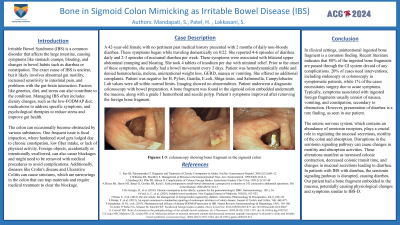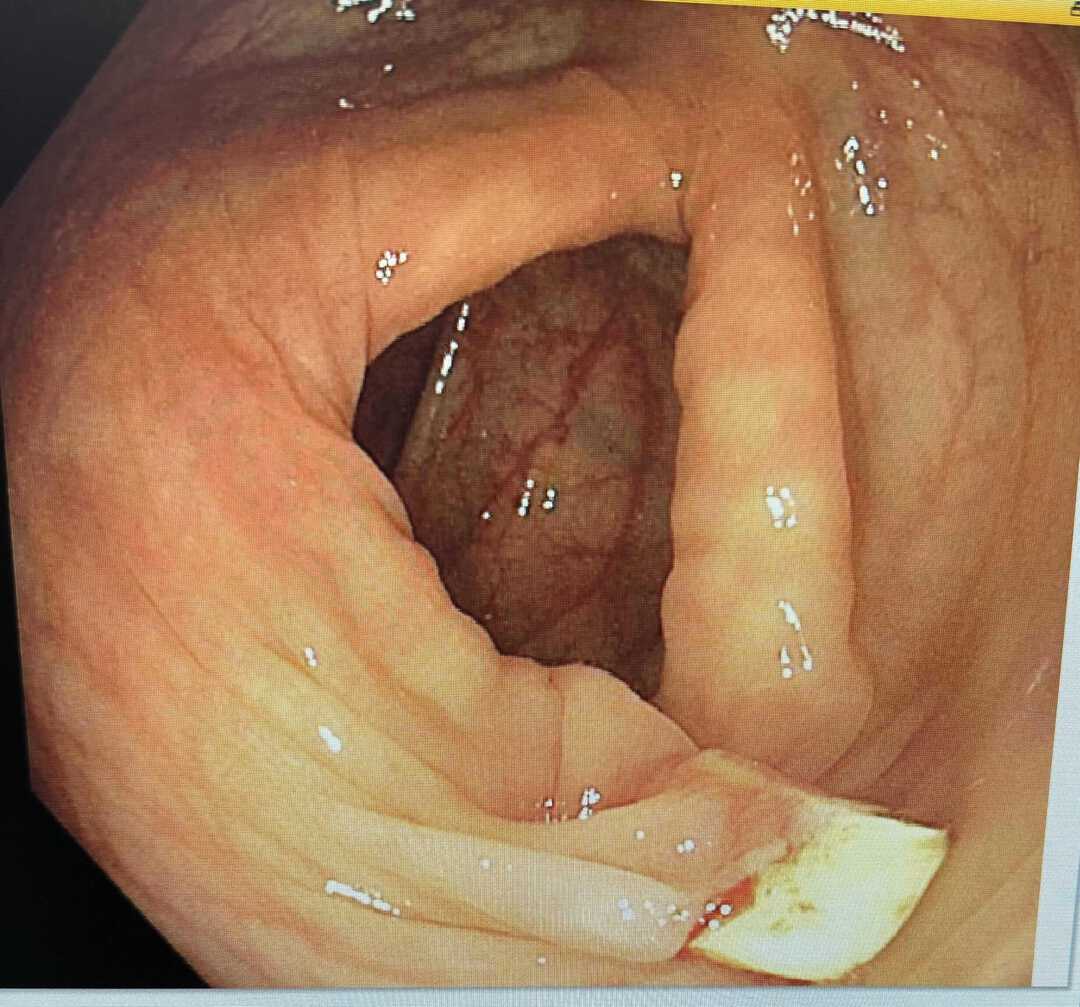Sunday Poster Session
Category: Colon
P0302 - Bone in Sigmoid Colon Mimicking as Irritable Bowel Disease (IBS)
Sunday, October 27, 2024
3:30 PM - 7:00 PM ET
Location: Exhibit Hall E

Has Audio

Sanjana Reddy Mandapati, DO
Rowan-Virtua School of Osteopathic Medicine
Newark, NJ
Presenting Author(s)
Saraswathi Lakkasani, MD1, Sanjana Mandapati, DO2, Christina Tennyson, MD3, Harsh V Patel, DO2
1Augusta Health, Glen Allen, VA; 2Rowan-Virtua School of Osteopathic Medicine, Newark, NJ; 3Augusta Health, Fishersville, VA
Introduction: The activity of the colon is partly controlled by the enteric nervous system which is communicated by the serotonin signaling pathway. Any changes in the colon can lead to increased levels of serotonin, causing diarrhea along with local inflammation. We present a 42 year old female with an unusual presentation of an ingested bone fragment in sigmoid colon with complaints of diarrhea, abdominal bloating and cramping. The removal of the bone fragment resolved her symptoms.
Case Description/Methods: A 42 year old female with no past medical history presented with 2 months of daily non-bloody diarrhea. She reported 4-6 episodes of diarrhea daily and 2-3 episodes of nocturnal diarrhea per week and upper abdominal cramping and bloating. Vital signs and physical examination are within normal limits.She took 4 tablets of imodium per day with minimal relief. Prior to the onset of these symptoms, she usually had a bowel movement every 2 days. Patient denied other Gastrointestinal symptoms. Routine blood and stool work up revealed no abnormal findings. In a diagnostic colonoscopy, a bone fragment was found in sigmoid colon embedded underneath the mucosa. Pathology came as a foreign body/Bone fragment. Patient’s symptoms improved after removing the foreign bone fragment.
Discussion: In clinical settings, unintentional ingested bone fragment is a common finding. Recent literature indicates that 80% of the ingested bone fragments are passed through the GI system devoid of any complications. 20% of cases need interventions, including endoscopy or colonoscopy in symptomatic patients, while 1% of the cases necessitates surgery due to acute symptoms. Typically, symptoms associated with ingested foreign fragments usually consist of nausea, vomiting, and constipation, secondary to obstruction. However, presentation of diarrhea is a rare finding, as seen in our patient.
The enteric nervous system, which contains an abundance of serotonin receptors, plays a crucial role in regulating the mucosal secretions, motility of the colon and absorption. Disruptions in the serotonin signaling pathway can cause changes in motility and absorption activities. These alterations manifest as increased colonic contraction, decreased colonic transit time, and changes in mucosal secretions leading to diarrhea. In patients with IBS with diarrhea, the serotonin signaling pathway is disrupted, causing diarrhea. Our patient had a bone fragment embedded in the mucosa, potentially causing physiological changes and symptoms similar to IBS-D.

Disclosures:
Saraswathi Lakkasani, MD1, Sanjana Mandapati, DO2, Christina Tennyson, MD3, Harsh V Patel, DO2. P0302 - Bone in Sigmoid Colon Mimicking as Irritable Bowel Disease (IBS), ACG 2024 Annual Scientific Meeting Abstracts. Philadelphia, PA: American College of Gastroenterology.
1Augusta Health, Glen Allen, VA; 2Rowan-Virtua School of Osteopathic Medicine, Newark, NJ; 3Augusta Health, Fishersville, VA
Introduction: The activity of the colon is partly controlled by the enteric nervous system which is communicated by the serotonin signaling pathway. Any changes in the colon can lead to increased levels of serotonin, causing diarrhea along with local inflammation. We present a 42 year old female with an unusual presentation of an ingested bone fragment in sigmoid colon with complaints of diarrhea, abdominal bloating and cramping. The removal of the bone fragment resolved her symptoms.
Case Description/Methods: A 42 year old female with no past medical history presented with 2 months of daily non-bloody diarrhea. She reported 4-6 episodes of diarrhea daily and 2-3 episodes of nocturnal diarrhea per week and upper abdominal cramping and bloating. Vital signs and physical examination are within normal limits.She took 4 tablets of imodium per day with minimal relief. Prior to the onset of these symptoms, she usually had a bowel movement every 2 days. Patient denied other Gastrointestinal symptoms. Routine blood and stool work up revealed no abnormal findings. In a diagnostic colonoscopy, a bone fragment was found in sigmoid colon embedded underneath the mucosa. Pathology came as a foreign body/Bone fragment. Patient’s symptoms improved after removing the foreign bone fragment.
Discussion: In clinical settings, unintentional ingested bone fragment is a common finding. Recent literature indicates that 80% of the ingested bone fragments are passed through the GI system devoid of any complications. 20% of cases need interventions, including endoscopy or colonoscopy in symptomatic patients, while 1% of the cases necessitates surgery due to acute symptoms. Typically, symptoms associated with ingested foreign fragments usually consist of nausea, vomiting, and constipation, secondary to obstruction. However, presentation of diarrhea is a rare finding, as seen in our patient.
The enteric nervous system, which contains an abundance of serotonin receptors, plays a crucial role in regulating the mucosal secretions, motility of the colon and absorption. Disruptions in the serotonin signaling pathway can cause changes in motility and absorption activities. These alterations manifest as increased colonic contraction, decreased colonic transit time, and changes in mucosal secretions leading to diarrhea. In patients with IBS with diarrhea, the serotonin signaling pathway is disrupted, causing diarrhea. Our patient had a bone fragment embedded in the mucosa, potentially causing physiological changes and symptoms similar to IBS-D.

Figure: Foreign bone fragment embedded in Sigmoid colon
Disclosures:
Saraswathi Lakkasani indicated no relevant financial relationships.
Sanjana Mandapati indicated no relevant financial relationships.
Christina Tennyson indicated no relevant financial relationships.
Harsh V Patel indicated no relevant financial relationships.
Saraswathi Lakkasani, MD1, Sanjana Mandapati, DO2, Christina Tennyson, MD3, Harsh V Patel, DO2. P0302 - Bone in Sigmoid Colon Mimicking as Irritable Bowel Disease (IBS), ACG 2024 Annual Scientific Meeting Abstracts. Philadelphia, PA: American College of Gastroenterology.
